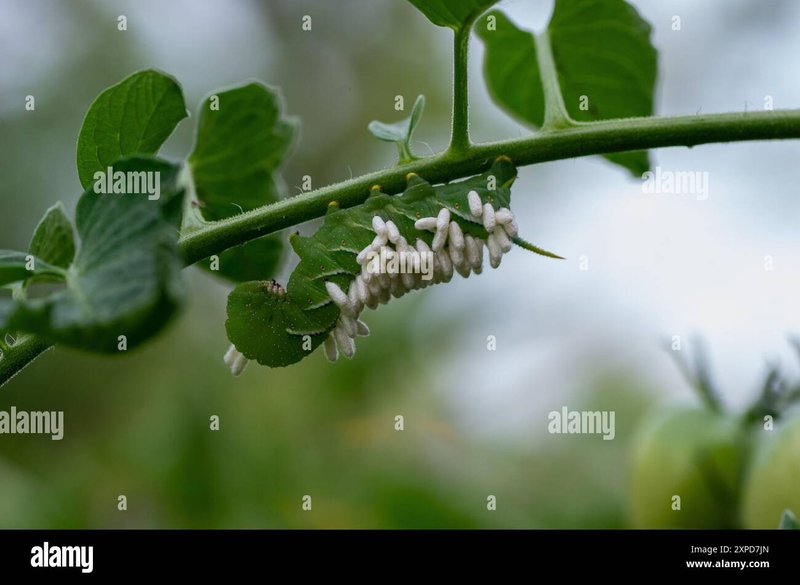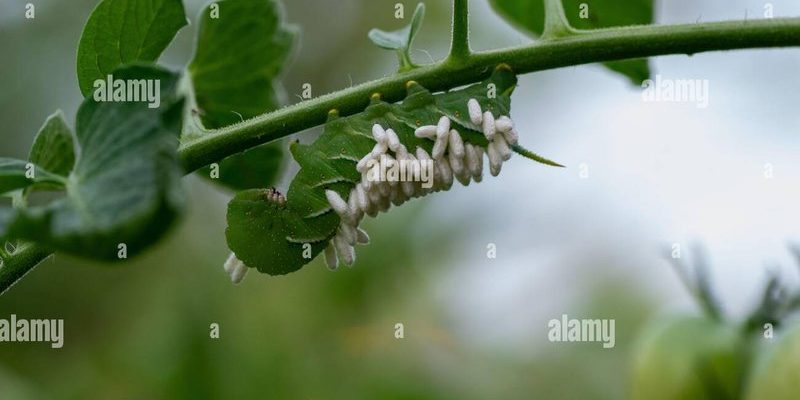
So, what does this parasitism actually look like? Imagine a once-thriving larva, now slowing down and covered in strange, pulsing lumps; this is where the real drama unfolds. Understanding these signs not only helps you keep your garden healthy but also educates you about the fascinating web of life that surrounds us. Let’s dive into recognizing the signs of parasitism in hornworm larvae and unravel some of the mysteries of these curious creatures.
What Are Hornworm Larvae?
Hornworm larvae, specifically the tobacco hornworm (*Manduca sexta*), are well-known garden pests. They’re the green, plump caterpillars that seem to appear overnight, feasting on the leaves of tomato, pepper, and eggplant plants. These larvae can grow up to 4 inches long and are notoriously good at hiding due to their color, blending in with the foliage.
However, as they munch away, these hornworms can fall victim to parasitic wasps, which lay their eggs inside the caterpillar. The wasp larvae then develop inside, ultimately leading to the demise of the hornworm. This cycle of life and death illustrates an intricate balance in nature, where even the most intimidating caterpillars have their own threats.
Understanding hornworm larvae is more than just knowing what they look like; it’s about appreciating their role in the ecosystem. They may be pests to gardeners, but they also serve as vital food sources for birds and other wildlife. When considering treatment strategies, it’s essential to keep this ecological balance in mind.
Common Signs of Parasitism
If you’re wondering whether your hornworm larvae are hosting unwelcome guests, there are several signs to look for. First and foremost, watch for the appearance of small, white or cream-colored cocoons on the larva’s body. These are the pupae of parasitic wasps, indicating that the hornworm has been infected.
Moreover, infected hornworms often display unusual behavior. You may notice them moving sluggishly, not eating as much, or even wandering away from your plants. This behavior can be puzzling at first, but it’s a clear signal that something is amiss.
Another telltale sign is the presence of dark, empty larval shells. If you find a hornworm that seems to be shriveled and hollow, it’s likely that it’s already been overtaken. These signs are crucial because they help you identify parasitized larvae before the wasps emerge, which can significantly impact your garden’s health.
How Parasitism Affects Hornworm Behavior
Parasitism doesn’t just take a toll on hornworm larvae physically; it can also dramatically change their behavior. One of the most striking changes is that parasitized hornworms often stop eating. You might find them resting motionless on a branch or leaf, which stands in stark contrast to the ravenous munching they typically display.
Additionally, these larvae may begin to wander off from their usual feeding spots. This behavior can look odd as they slowly move away from the ample food source, seemingly searching for a place to die. The reason? Parasitic wasps are experts at manipulating their host’s behavior to ensure they find a safe place to pupate.
This change in behavior can be concerning for gardeners, as it can lead to the spread of parasites if not addressed. It’s essential to keep a close eye on your plants and the larvae inhabiting them, especially during the warmer months when parasitism tends to spike.
Identifying Parasitized vs. Healthy Hornworms
Telling the difference between a healthy hornworm and one that’s been parasitized can be tricky at first. Healthy hornworms are plump, vibrant green, and actively feeding on your plants. They look like little fat caterpillars, almost like nature’s cartoon characters.
In contrast, parasitized hornworms often appear lethargic and may have noticeable changes in color. You might see them becoming a duller green or even grayish as they succumb to the parasitic life cycle. The presence of white cocoons is also a clear indicator of an infestation.
Conducting a visual inspection of your plants regularly can help catch these differences early. If you notice any hornworms that display these signs of parasitism, it’s best to remove them immediately to prevent the wasps from maturing and spreading.
The Role of Parasitism in the Ecosystem
While it can be distressing to see hornworms under siege by parasites, it’s essential to understand the ecological role of this phenomenon. Parasitism helps control the population of hornworms, which can otherwise decimate crops if left unchecked. Think of it as nature’s way of keeping balance in the garden.
Moreover, these tiny wasps, while harmful to hornworms, are generally harmless to humans and beneficial in controlling other pest species. They play a crucial role in integrated pest management (IPM) strategies, helping reduce reliance on chemical insecticides. By fostering a healthy ecosystem, we can promote natural pest control methods.
In some cases, encouraging these parasitic wasps can lead to healthier plants and reduced pest outbreaks. It’s a reminder that nature has its own checks and balances, and understanding these relationships can lead to more sustainable gardening practices.
What to Do If You Find Parasitized Hornworms
If you discover that your hornworms are indeed parasitized, there are a few steps you can follow. First, it’s often best to leave these larvae alone. Removing them can disturb the natural process, allowing the wasps to continue their life cycle and potentially save your garden from worse infestations later on.
If you prefer a more hands-on approach, you can gently remove the affected hornworms and place them in a location where they won’t harm your plants. Just remember to check for any remaining larvae or cocoons before disposal.
Additionally, consider fostering a habitat that attracts beneficial insects. Planting flowers that attract wasps and other pest control allies can create a more balanced ecosystem, reducing the need for chemical interventions in your garden.
Final Thoughts on Hornworm Parasitism
Spotting signs of parasitism in hornworm larvae can feel overwhelming at first, but it’s also a fascinating glimpse into the complex web of life in your garden. Recognizing these signs allows you to make informed decisions about how to protect your plants while also respecting the natural processes at play.
By understanding the behaviors and physical changes in hornworms, you can more easily navigate the ups and downs of gardening. The next time you encounter these larvae, you’ll have the knowledge to determine whether they’re simply doing their job or in the throes of a tiny drama that affects the whole ecosystem. Embrace the chaos of nature; it’s all part of the journey!

